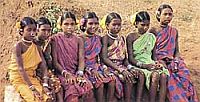Friday, April 19, 2024
News and Views from the Global South
INDIA: Mining Boom Affecting Tribals, Environment
Keya Acharya
- While India has been steadily attracting foreign investment into its booming mining sector, the fact that the best prospects lie in tribal-dominated and heavily forested areas is cause for concern.

The state-owned OMC has welfare programmes for tribals around its mines. Credit: Orissa Mining Corporation (OMC)
But the main concentrations of this mineral wealth happens to fall in the ecologically-rich, tribal-inhabited areas of south, central and northeastern India that has suffered neglect say environmentalists and development activists.
According to the 2001 census, there are more than 90 million tribal people in India, with large concentrations in the eastern and central Indian states, such as Orissa, Madhya Pradesh, Chattisgarh and Jharkhand. The human development report of the eastern Orissa state, the country’s richest mineral-bearing State, for instance, is an abysmal low of 0.404.
Less than 25 percent of the nearly 2.6 million people, over half of them tribals, displaced by mining from 1950 to 1991, have been rehabilitated.
A well-known New Delhi-based environmental organisation, the Centre for Science and Environment (CSE), has now begun a campaign to address the deep and disturbing problems of environmental degradation coupled with the largescale loss of homes and livelihoods in India’s rapidly ballooning mining industry, and in its latest mining policy.
CSE’s 6th State of India’s Environment Report, ‘Rich Lands, Poor People – Is Sustainable Mining Possible?’ disputes the government-industry argument that mining is good for growth and for employment through detailed studies on the impacts of mining in various states.
The CSE report, released earlier this month, counters the recommendations of the national mineral policy 2008 which expects large-scale foreign investment and the introduction of the latest technology in India’s mining sector.
The policy does admit that most mineral deposits are in forest areas and says a ‘sustainable framework’ should be worked out, along with rehabilitation for displaced tribals, but it fails to outline how these will be accomplished.
“Based on unrealistic assumptions, the policy fails to take into consideration the social and environmental problems happening due to mining. It is bound to promote large-scale exploitative mining and will, therefore, exacerbate conflict,’’ says Sunita Narain, director of CSE.
India’s policy on mining remained cautious till around 1997, but problems began surfacing when an economic liberalisation regime unplugged controls and allowed industry partial investment control in mining in 2000.
The situation aggravated when the government amended the policy in 2006 to allow 100 percent direct investment by foreign companies. Western mining interests jumped at the opportunity to get at impressive reserves for key minerals and a large, built-in market for them. Already India ranks among the five largest markets in the world for coal, steel and aluminium.
International firms like De Beers and Broken Hill Properties, both with controversial human rights and environmental company practice records in countries like South Africa and Papua New Guinea respectively, have acquired huge prospecting rights in Orissa and Madhya Pradesh.
Rio Tinto, another large and controversial mining company, has diamond and gold prospecting rights in Madhya Pradesh.
Alongside China’s demand for iron and steel, fuelled by its furious pace of development and by its Olympics’ setting demands, iron ore production in India jumped from 59 million tones (mt) from 1993-94 to 154 mt in 2005-06, bauxite from five mt to 12 mt in the same period, while coal-production increased from 267 mt to 437 mt.
Similarly, chromite production grew from 1.06 mt in 1993-1994 to 3 mt in 2005-2006, and natural gas production almost doubled from 16,340 million cubic metres (mcm) in 1995-1996 to 31,223 mcm in 2005-2006.
Yet, this huge spiralling production has contributed a mere 2.5 percent to the country’s GDP in the last ten years and yielded much smaller revenues for the government than it should have.
In southern mineral-rich Karnataka state, for instance, royalties from mining have remained a static 0.7 to 0.8 percent of total revenues even while the value of these minerals have shot up manifold. Illegal mining, due to unimplemented laws and corruption has been identified as a major factor, as in the rest of India.
” We have huge problems in not granting permission to industry, our hands are tied, we cannot impose any standards we deem necessary”, says the chairman of Karnataka’s State Pollution Control Board, H.C. Sharathchandra.
India’s Air and Water (Prevention and Control of Pollution) Acts allow pollution control agencies to check only ‘point’ [or final] sources of pollution, thus bypassing most of the problems caused by mining.
Staff shortages, lack of training and capacity, alongwith physically small mine areas that do not allow mining overburden to be corrected environmentally are other problems, says Sharathchandra.
One of Karnataka’s leading publishers, K.N. Shanth Kumar, said what worried him was the ” rapidly-growing influence of mining on the political sector of the country”.
“The issue involves law enforcement not being able to do their jobs effectively,’’ he said.
CSE director Sunita Narain said her group is now looking to ‘‘create a dialogue’’ between the various stakeholders of mining in India. “Our idea is not to polarise the discussion, but to integrate industry into it,’’ she said.

 Print
Print



